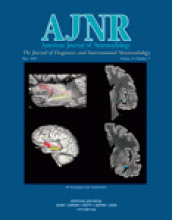Abstract
BACKGROUND AND PURPOSE: Asymptomatic microbleeds shown by T2*-weighted MR imaging are associated with small-artery diseases, especially with intracerebral hemorrhage. Few studies have focused on the prevalence of microbleeds in patients with recurrent stroke. We investigated frequency of microbleeds in patients with recurrent stroke and association of presence of microbleeds with a combination of stroke subtypes and severity of leukoaraiosis.
METHODS: The study population consisted of 102 patients with primary stroke and 54 patients with recurrent stroke. Microbleeds were counted and classified by using T2*-weighted MR imaging with a 1.0-T system.
RESULTS: Patients with recurrent stroke showed a significantly higher prevalence of microbleeds (68.5%) than did patients with primary stroke (28.4%) (P < .0001). Among patients with recurrent stroke, the highest frequency of microbleeds occurred in those with intracerebral hemorrhage alone (92.3%), with the next highest frequency occurring in those with a combination of intracerebral hemorrhage and ischemic stroke (76.5%) and then those with ischemic stroke alone (50.0%) (P < .05). Leukoaraiosis was more severe in patients with recurrent stroke than in patients with primary stroke, and correlations between grade of microbleeds and severity of leukoaraiosis were found in patients with primary stroke (r = 0.367, P < .001) and in patients with recurrent stroke (r = 0.553, P < .0001). Logistic regression analysis identified recurrent stroke (odds ratio, 4.487; 95% confidence interval, 1.989−10.120) and leukoaraiosis (odds ratio, 5.079; 95% confidence interval, 2.125−12.143) as being significantly and independently associated with microbleeds.
CONCLUSION: Asymptomatic microbleeds are observed to occur frequently in patients with recurrent stroke, either hemorrhagic or ischemic stroke, and are closely associated with the severity of leukoaraiosis.
- Copyright © American Society of Neuroradiology







